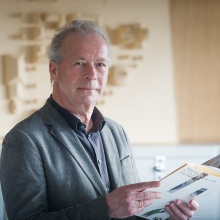Prof. Klaus Jan Philipp, Head of the Institute of Architectural History, is the university's representative for the IBA 2027 Stuttgart Region. Research assistant Lena Engelfried assists him in this task, which she describes as follows: “We help with project submission and provide practical advice. We want to bring together various stakeholders from the university and pool ideas in order to achieve synergies. In addition, we act as an interface between the university and the IBA.” The university's vision “Intelligent Systems for a Sustainable Society” fits in very well with the IBA topics of sustainability, ecology, mobility, social affairs, and climate, Prof. Philipp explains. “These topics of the future go far beyond the matter of building.”
Next meeting of the steering committee: 28 April
Anyone interested is welcome to join the steering committee or submit ideas.
Presenting and discussing ideas in the steering group
An important body for presenting ideas from the university is the IBA steering committee, which was established by Prof. Klaus Jan Philipp and takes place four times a year. Representatives of faculties 1, 2, 4, 5, 9, and 10 have been involved so far. “We see ourselves as an open working group,” says Philipp. “Here we collect and examine and present our ideas, and put them up for discussion. Together we want to find out which projects are suitable for submission, which formats could be selected, and which could be realized at the festivals.” In addition, the steering group sees itself as a kind of supervisory board to ensure the quality of the projects that are submitted by the university. Philipp adds: “The submitted projects are currently being collected by the IBA. In the course of the year, the IBA board of trustees and the supervisory board will make initial decisions as to which projects should be followed up until 2027.”
The steering group is in close contact with representatives of the IBA project management. Also, it is planned to invite Andreas Hofer, the director and general manager of the IBA, in the summer semester.
From the cafeteria to mobility concepts to a high-rise demonstrator building
The ideas discussed so far in the steering group include all kinds of projects, from smaller projects such as the planning of exhibitions, to large ones such as the demonstrator buildings. At the recent steering group meeting in January, Prof. Stephan Trüby, Head of the Institute of Theory of Architecture and Design (IGmA), presented a project that is being developed together with students: the Cafeteria of Looking Good for the Campus City Center.
The Campus HUB, a cross-university learning center on the Campus city center, is one of the larger projects in the city center. Philipp hopes that these projects will help to strengthen the connection between the university and the city: “The IBA provides a window to urban society.”
Specifically, two demonstrators are to be constructed on the campus in Vaihingen: One of the demonstrator buildings that are currently being planned belongs to the Cluster of Excellence “Integrative Computational Design and Construction for Architecture” (IntCDC). The other one is a 37-meter, adaptive high-rise building of the SFB 1244 “Adaptive Skins and Structures for the Built Environment of Tomorrow”.
The buildings of the Cluster of Excellence and the SFB 1244 are to be completed by 2023 and become part of the IBA Festival. The latter building is expected to be constructed later this year. “For other new buildings, too, we want to check whether we can formulate them as an IBA project,” reports Prof. Klaus Jan Philipp. Other projects that are expected to be submitted are the innovative mobility concept “MobiLab” for the Vaihingen campus and the “Climate Real-Time Laboratory”, which has been put out to tender by the Ministry of Science, Research and the Arts.
IBA creates international appeal
Engelfried and Philipp are convinced that the IBA will create international appeal and provide an excellent opportunity for the university to present itself. Now it is important to keep the interest in the IBA alive over the seven years. It seems to be working well at the moment. “The IBA idea is slowly starting to grow, everyone is realizing that something is getting underway,” says Prof. Klaus Jan Philipp.
IBA 2027 Stuttgart City Region
The 2027 International Architecture Exhibition (IBA) will take place in Stuttgart and the Stuttgart Region. In addition to the City of Stuttgart, partners of the IBA include the Verband Region Stuttgart (the political entity of the Stuttgart Region), the Stuttgart Region Economic Development Corporation, the Baden-Wuerttemberg Chamber of Architects, and the University of Stuttgart. This role of a university at an IBA is a novelty. The IBA addresses the five thematic areas “Productive City”, “The Future of the Centers”, “Places of Movement and Encounter”, “The Legacy of Modernity”, and “The Neckar as an Environment To Live In”. Representatives from politics, society, and science, including professors from the University of Stuttgart, will be involved in specialist forums. About 90 projects have been submitted to the IBA so far. Some of these will remain concepts or be temporary. In addition to the actual IBA in 2027, festivals are planned for 2023 and 2025.
www.iba27.de




